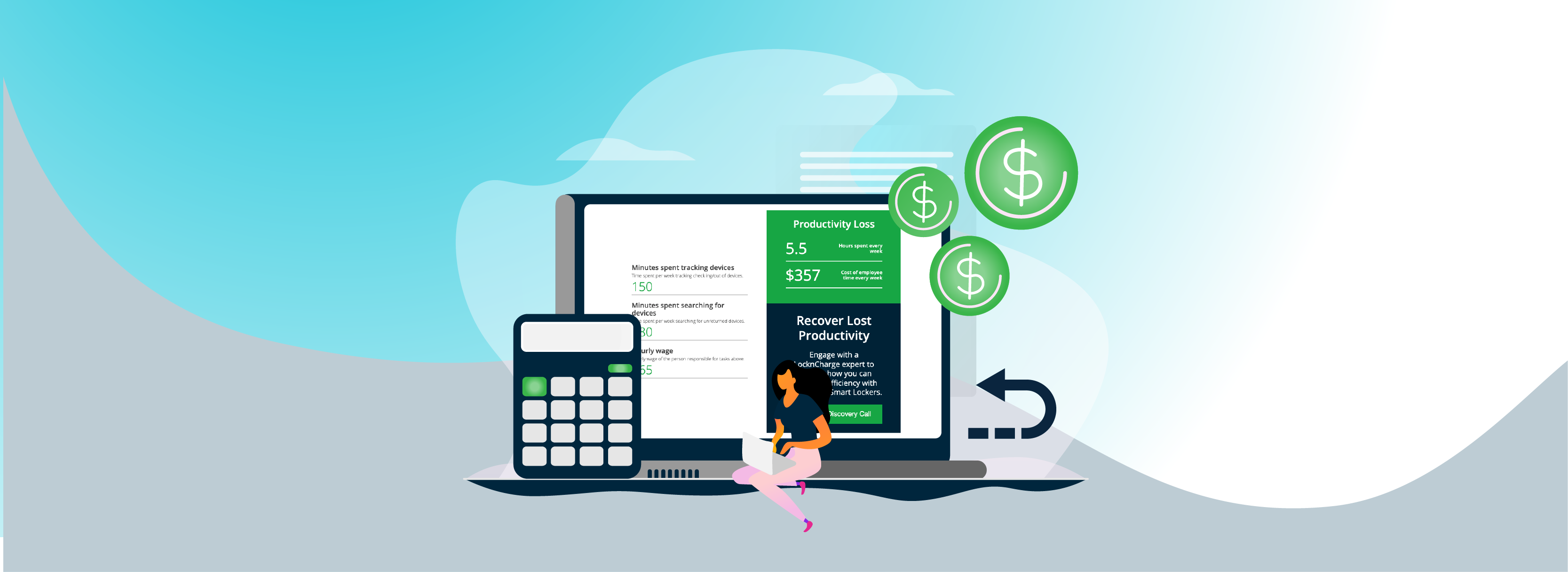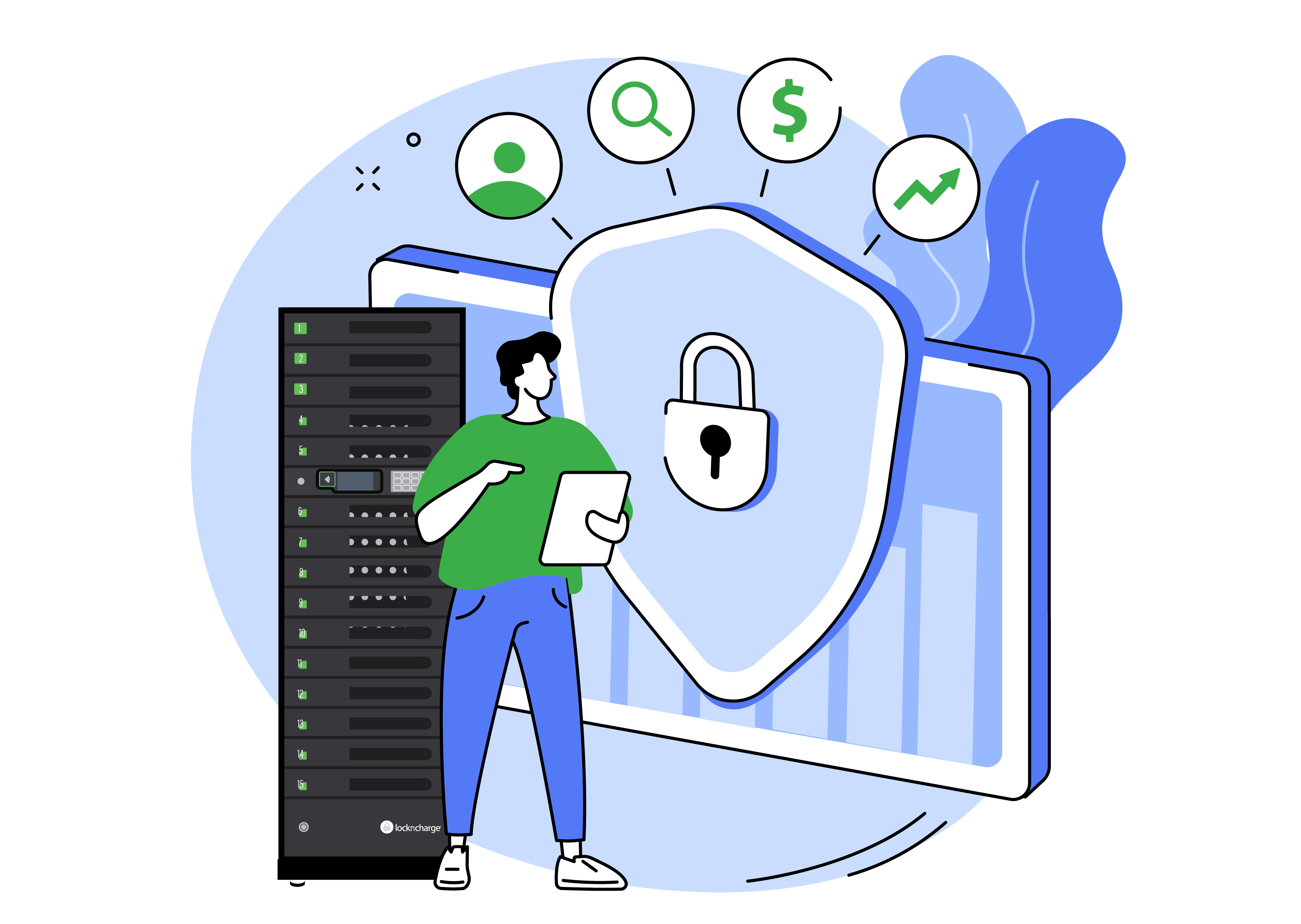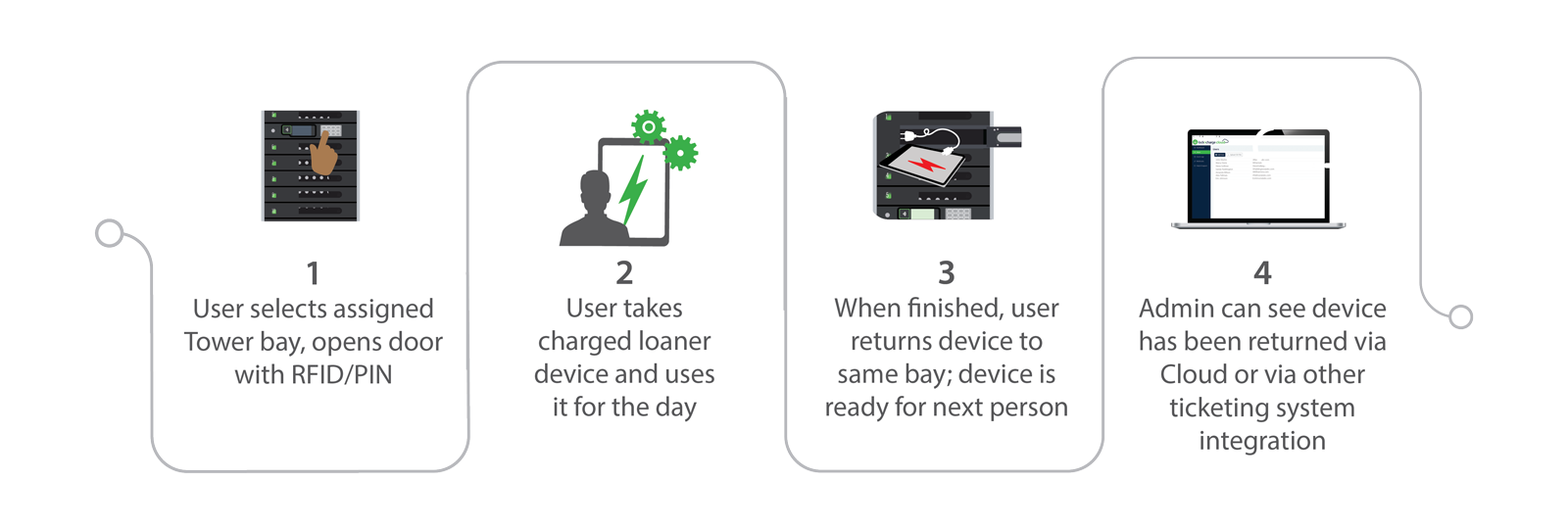Calculate Your Lost Productivity for a Manual Check In/Out Device Workflow

Many organizations offer short-term or long-term mobile device check outs for employees, shift workers, field workers, students, teachers, substitute teachers, guests or others.
Highly-successful executives and managers who are responsible for managing these mobile device programs tell us they are frustrated by the following:
- Shared devices are not readily accessible nor reliably charged, delaying the day.
- Managers are forced to prioritize distributing and collecting devices over their primary operational roles.
- Device breakage and loss is significant for shared devices that are not secured or tracked.
- Data is exposed when devices are not securely stored, and MDM software is not enough.
If any of these pain points sound familiar, the first step toward finding a solution is to quantify the problem.
Calculate Lost Resources and Productivity for a Manual Check In/Out Device Workflow
Calculate Lost Productivity for Manual Broken Device Exchanges
Many organizations also experience frustrations with manual broken device exchanges. Click the link below to calculate the productivity loss of your manual break/fix workflow.
The Best Mobile Device Management and Physical Security Strategy

Mobile device management (MDM) is more critical to businesses than ever before. Mobile devices are convenient and affordable, making them a must-have for many organizations. But with the rise in mobile devices comes a rise in security risks. Having a strategy for this modern work environment is no longer an option, it’s a necessity.
According to Verizon’s recent Mobile Security Index report, 40% of respondents said that mobile devices are the biggest IT security threat, and over half categorized the consequences they suffered from a mobile-device-related security compromise as “major.” And cyberattacks on businesses have increased by 50% year over year.
The threat of intellectual property loss and reputational damage is real. But as the use of these devices skyrockets thanks to remote learning and working, the benefits of mobile device management can no longer be ignored. Here’s what organizations need to know.
What Is Mobile Device Management?
Mobile device management is an organization’s strategy to monitor and secure devices in order to reduce theft, loss and device misuse. Common MDM best practices include:
- Disk encryption
- Strong passwords and two-factor authentication
- Limited log-in time and automatic logout
- Use of anti-virus software
- Automatically blocking or disabling unapproved apps
- Keeping all device software up to date and performing regular backups
- Ability to wipe data remotely for lost or stolen devices
The best MDM strategies also include physical device management, such as keeping track of inventory, implementing secure check-in/check-out with smart lockers and providing training that keeps everyone on the same page. That’s how organizations can realize the biggest benefits of MDM.
Benefits of Mobile Device Management
A well-thought-out MDM strategy has plenty of benefits, including:
- Better security. Even if your organization doesn’t collect personal data that needs to be protected, mobile device management can also help keep intellectual property and other important information secure.
- Accountability. The ability to track who has which device at any given moment improves accountability and helps ensure devices are returned and charged properly.
- Application control. MDM means you can not only control which apps are on your devices, but also automate updates and sync devices to keep files and programs uniform.
- Lower costs. Over the long-term, all of these things result in one ultimate benefit for your organization: reduced costs due to fewer lost and stolen devices and improved efficiency.
Physical Device Security as Part of a Mobile Device Management Strategy
Many businesses are taking steps such as incorporating up-to-date MDM security software. But software alone might no longer be enough. Physical security is also essential, which is why many organizations are turning to mobile device charging stations and the FUYL Smart Locker System as a part of their MDM strategy.
Smart lockers are more than just a place to store a device. They can help protect your devices against security breaches and compromised data and can save time and resources spent tracking down, fixing and replacing devices. Their benefits include:
- Theft prevention. Devices can be locked and protected in an ultra-secure, high-quality smart locker to help prevent device theft. That can help mitigate your risk of a data breach and lower your costs for replacing stolen devices.
- Improved productivity. With power outlets and USB ports that can charge a variety of devices and let you know when they’re available for use, smart lockers help ensure that employees have access to fully charged devices for every shift.
- Reduced downtime. When devices are properly stored, charged and secured in smart lockers or charging stations, employees and students can self-service a replacement whenever they need one, reducing interruptions and downtime.
- Increased efficiency. Smart lockers or charging stations can help you automate processes for check in/out, break/fix, and shared or loaner devices, allowing skilled IT teams to focus on more important strategic projects and saving you labor costs.
How the FUYL Smart Locke System Helps Support Your Mobile Device Management Strategy
Solutions like the FUYL Smart Locker System can support a mobile device management strategy. Your team can allow access to designated bays remotely, reducing the need for time-consuming face-to-face interactions and staying in step with the future of IT and operations. Plus our smart lockers offer benefits not matched by our competitors, like:
Quality materials and lifetime warranties. Our products are made with high-quality steel and most are backed by a lifetime warranty. Your devices will be protected today, tomorrow and well into the future.
- Feature-rich cloud platform with data protection. With the LocknCharge Cloud, you can store data in the cloud, which can be protected with industry-standard encryption certificates and regulated admin access.
- Future-proof flexibility. Easily switch modes thanks to Cloud connections that can flex to new workflows as tech advances and device management needs change.
- Unmatched customer support. Our local Customer Support Team will help solve any issue you may have with your smart lockers. Plus, a dedicated support website empowers you with valuable resources to troubleshoot commonly asked questions.
Schedule a Live Product Demo
Ready to experience the benefits of LocknCharge smart lockers for yourself? Talk to an expert today to learn how we can help you improve your mobile device management.
4 Ways to Combat the IT Labor Shortage
While the United States grapples with an overall labor shortage, there’s one industry in which it’s nothing new: information technology. There were more than one million open IT positions in the US alone in late 2019, and articles about the growing need for tech talent have proliferated for at least a decade.
Yet the IT labor shortage has increased over the past year: 64% of IT executives cited talent shortages as the most significant barrier to the adoption of emerging technology in 2021, compared with only 4% in 2020. Executives even ranked it higher than supply chain issues and cybersecurity threats.
At the same time, we need technology more than ever: To communicate with loved ones, to make our lives easier and especially to help schools, businesses and other organizations run efficiently and effectively. So what can a business owner or manager do about the IT worker shortage?
What’s Causing the IT Labor Shortage?
As we mentioned, the IT worker shortage isn’t new. Businesses have known for years that the adoption of new technologies is outpacing the abilities of the human beings who need to deploy them. Some of the shortage can be traced back to organizations’ hesitance to invest in training for inexperienced employees, preferring instead to hire those with experience – a limited pool that is getting smaller.
When the global pandemic hit, shifts in the way we work caused the IT labor shortage to accelerate even more. As businesses scaled up remote work, they suddenly needed to build new digital infrastructures – and they needed more employees with new areas of expertise, like cloud computing, mobile device security and networking. In 2021, 58 percent of IT professionals reported an increase in emerging technology investment in 2021, compared with 29 percent in 2020.
With increased demand for their skills, IT workers found themselves in better negotiating positions. That could be why 72% of tech workers are thinking of quitting or exploring new job opportunities in the next 12 months. Many workers are burned out, and they’re going elsewhere to get the professional development and flexible work schedules they desire.
4 Ways to Combat the IT Labor Shortage
New technologies undoubtedly benefit your business, school or organization. While it may feel like the IT worker shortage is beyond your control, there are solutions you can implement to help mitigate its effects and find new ways of operating.
1. Plan Ahead
Many organizations are still operating on the old-school model: When an IT worker quits, they backfill the role. But filling an in-demand tech role takes an average of 61 days, almost 20 days longer than a non-tech role. Plus, with so many leaders focused on implementing emerging technologies, it’s a good bet that you’re going to need to grow your IT team in the future. So why not forward-fill, instead of backfill?
Get ahead of the IT labor shortage by making a plan detailing which tech you want to roll out and when, then focus on hiring ahead of time. Better yet, upskill your existing workforce with both hard and soft skills: 75% of tech workers agree that their companies focus more on attracting new employees instead of investing in the existing ones – a big mistake.
2. Modernize Your Tech
Modernizing your tech in other areas of your organization is often a priority, but what about the tech that makes it possible for your IT team to do their jobs? Is there an existing software, API or AI-enabled tool that could help you mitigate the IT labor shortage by eliminating the need to hire a new person?
Also consider how you can more fully modernize your existing tech. If your organization uses mobile devices like tablets or laptops, for example, you don’t just want to ensure those are up-to-date. You’ll also want to make sure you have the best charging stations not only for your current devices but for future technology as well.
3. Automate Your Workflow
The costs of device repair, replacement and sharing go beyond the price of the device itself. When calculating an average labor cost, one hour per exchange and 5 exchanges per location, nearly 250+ hours and $25K+ is spent annually by an IT team manually exchanging devices.
Automating your break/fix and check in/out workflows can save your team hundreds of hours – time that’s particularly valuable during an IT worker shortage.
With a smart locker like the FUYL Tower, you can allow access to a designated bay via RFID or PIN, eliminating the need for slow, face-to-face drop-off and pick-up processes. When a device user, such as a student or employee, submits a request to your Help Desk, your IT team can respond remotely, allowing the student or employee to quickly trade their broken device from a FUYL Tower and get back to being productive. Arbor Park School District 145 saw these benefits first-hand.
CTO David Termunde says, “The Tower is like having another part-time IT person.”
Sorry, we couldn't find any posts. Please try a different search.
4. Improve Device Tracking and Security
When it comes to a check in/out workflow, tech teams and department managers are wasting time managing daily device checkouts for people like shift workers, substitute teachers and others.
Yet 86% of IT professionals report that someone in their organization has had a laptop lost or stolen – and 56% said it resulted in a data breach. Dealing with lost devices is time-consuming, and considering that 63% of IT managers said their non-security workload increased over the course of 2020, there’s simply no time for unnecessary breaches.
The FUYL Tower perfectly complements your device tracking strategy, helping to improve accountability and ensure devices are returned, plugged in and ready for the next user. Lost devices are reported more quickly so that security processes can be implemented. And it’s easy to regulate who can access devices and when, and help track when devices are returned, helping improve overall device security.
There’s no easy answer to the IT labor shortage. A long-term fix will likely include elements of training, higher pay and benefits and better planning. For now, organizations are smart to look at their device management strategies as one area with a high potential for cost savings and operational efficiencies. Contact the experts at LocknCharge to start improving your strategy today.
How Much Does Your Device Repair and Replacement Process Really Cost?
As more employees shift to remote or hybrid work models the cost of mobile device repair and replacement is expected to rise. At home, kids spill drinks on laptops, pets step on keyboards and food crumbs damage circuitry. Then there’s the accidental damage that goes along with lugging your devices to and from the office, not to mention the increase in forgotten charging cords, power supplies and other vital equipment.
Phone, laptop and tablet repair costs are quickly becoming a significant business expense – but do you know how much they’re really costing you? Mobile device repair drains your IT resources and results in downtime for employees who are unable to work. An efficient break/fix and replacement process is essential to help your employees stay productive.
How Much Does It Cost to Repair a Tablet or Laptop?
Tablet repair costs vary widely based on the age of the device, the model and the repairs needed. Screen replacement alone can vary by hundreds of dollars. For a newer iPad model, it can cost anywhere from $200 to $400, but older models may cost less. Other common tablet problems, like faulty charging ports or volume buttons, cost around $100 to fix.
So how much does laptop repair cost? Laptop screen replacement may cost more than a tablet because they have larger screens. Faulty power jacks, broken keyboards and fans and other common hardware problems cost between $100 and $250. Larger laptop repair costs like issues with the motherboard or hard drive can easily run you more than $200.
The True Cost of Mobile Device Repair
Putting a price on mobile device repair isn’t easy for a business, and the above costs don’t take into account lost productivity. When nearly 20% of mobile devices break or go missing each year, the burden falls on your IT staff. Yet one of the top complaints by IT staff is that they don’t have enough time to complete their current workload.
Have you ever asked yourself just how much time your IT department wastes on workforce technology deployment? Physically running around gathering and replacing broken devices or supplying cables? Consider this:
- The average fully-burdened labor cost for IT technical work ranges between $75 and $150 per hour
- When working in an office, it takes about an hour to exchange a device manually
- The average number of laptop and devices exchanges per week per location is around 5
That’s over 250 hours and nearly $25,000 per year just to exchange devices! While it may not be possible to eradicate all system and equipment issues, there’s a better solution to decrease device downtime and reduce workloads – and you won’t need to hire more people, create more manual workarounds or outsource the issue.
Calculate the Costs of Your Break/Fix Program
How to Streamline Your Mobile Device Repair Program
By deploying a cloud-based smart locker such as a FUYL Tower, you can eliminate many of the manual workflow processes of break/fix programs, simplify replacing damaged, lost or forgotten devices, and help lower your laptop and tablet repair costs.
Automate Your Break/Fix Program
Looking for an IT cost savings idea? Centralize and automate your time-wasting manual device exchanges with a smart charging locker. A FUYL Tower 5 or 15 allows you to keep several devices charged, secure and connected in an accessible location.
When a staff member breaks a device, simply send them to the locker to get a replacement. Not only does this solution save time and money, but it can also make your team’s lives easier. Employees can simply swap their broken device for a new one and be on their way with a new device. With FUYL Towers and the powerful LocknCharge Cloud platform, a manual process that once took an hour to complete now takes less than a minute.
With FUYL Towers, a manual process that once took an hour to complete now takes less than a minute.
To automate this process even further, LocknCharge Cloud can be integrated with your current IT ticketing system, such as Incident IQ, Learn21's Tech Director Toolbox, ServiceNow or another ITSM platform with API integration. Then you can automatically find a Tower bay that is suitable for the user and notify the user with directions to collect their device.
Simplify Equipment Distribution
FUYL Towers accommodate and charge almost any device, with or without cases. But what happens when your employee needs a different piece of equipment, such as a replacement cable? Or when HR has paperwork to be signed? Employees often need more than just a laptop to perform their jobs.
With a FUYL Tower, simplify the distribution of any item that fits a 14” (W) x 17” (L) x 3” (H) slot. Grant specific users access to individual bays by using their RFID badge or assigned PIN code. Employees can then easily access supplies, and you can view a detailed event log to know who accessed bays and when.
Read more tips to better manage remote workers, including the steps to deploy a zero-touch model for maintaining devices and equipment.
Streamline the Process for Ready-to-Go Devices
With a FUYL Tower filled with ready-to-go devices, you’ll reduce in-person interactions and speed up the check-in/check-out and mobile device repair process. Just ask the IT team of one of the largest energy companies in the U.S. who recently automated their device check-in/check-out process.
They deployed a fleet of mobile devices for their customer-facing departments to achieve greater operating efficiencies, adapt to evolving regulatory requirements, provide complete and accurate information to field employees and better communicate with the field.
They needed to implement a system to help manage these mobile devices. With the FUYL Tower, the IT team can assign specific lockers and devices to employees and restrict and monitor access to these devices. This process added another layer of accountability for employee devices and streamlined IT’s ability to manage thousands of devices remotely. FUYL Towers helped automate a manual process for managing devices and ensure that field technicians have the information they need to do their jobs effectively.
Calculate the Costs of Your Check In/Out Program
Choose the Right Secure Charging Locker
By automating the clunky mobile device repair and replacement process, LocknCharge FUYL Tower 5 or 15 charging lockers allow organizations to save a considerable amount of time, not to mention reduce staff frustration caused by frequent interruptions.
Get a return on investment between 10 to 16 weeks.
- Get a return on investment between 10 to 16 weeks. Whether your associates are checking out devices daily or you’re seeking to automate your loaner program, the average ROI is no more than four months.
- Leverage for broken device exchanges or device check-in/out environments. Easily store fully-charged, ready-to-use devices inside the locker bay until the administrator provides access to a user. Administrators can also assign a specific compartment to a single user.
- Address safety concerns and reduce risk. The system offers self-service with the swipe of an RFID badge, eliminating the need for human intervention to check out a device or pick up a loaner.
- Easily scale as your business grows. The LocknCharge Cloud allows you to manage thousands of users and shave time off tasks you once had to do manually. These minutes gained by everyone involved help to increase ROI.
- Rely on us for peace of mind. Our customer support has a world-class Net Promoter Score (NPS), and our products come with a lifetime warranty to ensure peace of mind.
Schedule a Live Product Demo or ROI Evaluation
If you’re curious how FUYL Tower could integrate into your operational workflow, we’re here to help. LocknCharge exists to make life easier for mobile technology users by creating solutions that ensure accessibility and usability of devices at all times. Get in touch with LocknCharge today to set up a demo or to get a custom FUYL Tower ROI Evaluation.
How a Customer-Centric Philosophy Drives Product and Software Development at LocknCharge

Technology is changing faster than ever before. In this new era of digital transformation, mobile tech and smart devices have become an instrumental part of the change. Smart Lockers, for example, stepped up to the challenge of helping implement safe and efficient workflows in remote and hybrid work environments.
But as technology continues to rapidly evolve - and future transformations remain on the horizon - ensuring the products you buy and the software they come with are backed by a customer-centric company is essential. This means that consistent enhancements and new features will always keep you and your bottom line resilient, no matter what lies ahead.
At LocknCharge, our relationship doesn’t end with our customers when they buy a product. Our Cloud-based Smart Lockers are device management investments with universal compatibility for your laptops and tablets that come with long term benefits to your company, and the cultivation of that relationship begins with our nimble and highly-skilled internal team.
To better control costs, some companies look to hire outsourced software development teams. At LocknCharge, the agility we pass on to the customer is powered by our in-house development team instead. The benefit of direct communication and immediate support our internal team provides allows us to ensure that customer experiences are always at the forefront. Recent research has also shown that the link between software development and innovation is strongest for firms that develop software in-house.
Our smaller-scale company structure also helps in an age of rapid transformation. We’re able to both address and solve customer needs quickly and efficiently.
Here’s a behind-the-scenes Q&A with Vlad Vasilciuc, Director of Product Management at LocknCharge, where we discuss how our customer-centric philosophy comes to life and why it’s important for us to always look to our customers for feedback at every stage of product development.

What do you and your team do as part of product management at LocknCharge?
VV: I am the Product Manager at LocknCharge, but also manage our in-house software development team. In this role, I am the bridge between the technical development teams, and sales, marketing, and customers. My job is to understand customer workflows, pains, and goals – and then work with a variety of stakeholders in how best to solve them.
What makes LocknCharge a customer-centric company?
VV: We try and validate feature development at various phases in the development cycle. As we prototype, we reach out to end customers to validate that the changes we’re making are solving their pain points. We try to ground our product development on real customer data.
With tech advancing so quickly, how often are updates and enhancements being made to smart locker systems?
VV: When it comes to our LocknCharge Cloud software platform and our Smart Lockers, we’re releasing enhancements on a weekly basis. Our releases may not always include features, but we are making incremental improvements to the platform. In doing so, we ensure that our systems are up to date and that our platform is as secure as possible. Improvements in any given release may include security updates, UI improvements, bug fixes, etc.
How is the LocknCharge product team so nimble when it comes to bringing these enhancements to customers?
VV: All of our development is done in-house. From the physical, mechanical design, to the electronics, to the software and firmware – we have specialist engineers that do the research and development to respond to urgent requirements. Couple that with our access to customers globally, and we can get answers to questions more quickly than if we were relying on outsourced specialists. Outsourced development can lead to longer wait times between prototype phases as well as lengthy product feedback loops.
How has customer feedback impacted enhancements and new features at LocknCharge?
VV: We follow a methodology that is “continual improvement, continual deployment.” That means that we are releasing bite size chunks of a feature, which allows for shorter customer feedback loops. As we release a small part of the feature, users can start interacting with it a lot earlier than if we were to develop the feature in its entirety. This means that instead of relying on assumptions, we’re able to get real-world use cases and validation as we develop, and we can change course as feedback comes in.
What are some features of LocknCharge products that have emerged from taking customer feedback into account?
VV: To give some context before I talk about features, the key product category that I manage is Smart Lockers. Our current lineup of Cloud-based smart lockers for device management are designed for managing and charging laptop and tablet devices, allowing customers to automate the deployment and access to those devices.
One feature that we recently completed is the ‘External Users’ feature. This feature allows customers to connect their user directory to our system and automates who is allowed access to the contents of the smart locker compartments. So, in a check-in/check-out workflow, administrators of the FUYL Tower Smart Lockers can grant access to users based on their group permission set defined in their system. The benefit of integrating or connecting to their user directory is that the user administrator only has to manage one user directory – their own. There is just one source of truth. If an employee leaves their organization, they don’t have to update users in other systems that may have a copy of their users. Once it’s updated in their user directory, it’s updating in all the other connected systems, saving them time, and giving them peace of mind that their access has been fully revoked.
How was the process of that feature developed?
VV: It’s very difficult to support integrating every user directory on the market as there are lots and lots of them. So, we initially got some data on what the most popular user directories were, and then validated the data with a survey and customer interviews.
The results gave us a good starting point, but also recognized that the data was still limited. We developed with the idea in mind that we would have customers reach out to us after the release of the feature with feedback and additional requirements. And that’s exactly what happened. Because we allowed for this in our design, we were able to add additional requirements quickly.
How has the pandemic changed this process or priorities when it comes to being customer centric?
VV: The pandemic has definitely made our process more challenging. Along with customer calls and surveys, we like to get out to customer sites and observe the product in use. But our situation isn’t unique, and just like many other organizations, we’ve had to adapt. We use a lot of online tools to get the feedback we need.
How did you ensure that LocknCharge products are future proof?
VV: We ensure our projects are future proof by doing market research, watching tech trends, gathering sales and marketing feedback, and constantly talking to customers are methods that help us develop adaptable products. We also look at usage data and overlay that with what we are seeing and hearing in the field.




